Dual Topoisomerase Inhibitor Is Highly Potent and Improves Antitumor Response to Radiotherapy in Cervical Carcinoma †
Abstract
1. Introduction
2. Results
2.1. P8-D6 Induces Apoptosis in 2D Cervical Carcinoma Cells
2.2. P8-D6 Induces Strong Effects in 3D Target Tumor
2.3. P8-D6 Induces Strong Effects in Ex Vivo Primary Tumor Cells
2.4. P8-D6 Sensitizes Cervical Carcinoma Cells to Radiotherapy in 3D Cell Culture
3. Discussion
4. Materials and Methods
4.1. Cell Preparation and Culture
4.2. 2D Cell Culture
4.2.1. 2D Viability and Apoptosis
4.2.2. Fluorescence Imaging (LSM)
4.3. 3D Cell Culture
4.3.1. 3D Viability, Apoptosis and Cytotoxicity
4.3.2. Scanning Electron Microscopy
4.3.3. Radiotherapy
4.4. Combination Index and Dose Reduction Index
4.5. Statistical Analysis
5. Conclusions
6. Patents
Supplementary Materials
Author Contributions
Funding
Institutional Review Board Statement
Informed Consent Statement
Data Availability Statement
Acknowledgments
Conflicts of Interest
Abbreviations
| 2D | Two-Dimensional |
| 3D | Three-Dimensional |
| CI | Combination Index |
| DRI | Dose Reduction Index |
| fa | Fraction Affected |
| Gy | Gray |
| HDI | Human Development Index |
| HPV | Human Papillomavirus |
| IC50 | Inhibitory Concentration 50% |
| LSM | Laser Scanning Microscopy |
| PARP | Poly-ADP-Ribose Polymerase |
| PBS | Phosphate-Buffered Saline |
| PD-L1 | Programmed Cell Death-Ligand 1 |
| PI | Propidium Iodide |
| RFU | Relative Fluorescence Units |
| RLU | Relative Luminescence Units |
| SEM | Standard Error of Mean |
| TME | Tumor Microenvironment |
References
- Bray, F.; Laversanne, M.; Sung, H.; Ferlay, J.; Siegel, R.L.; Soerjomataram, I.; Jemal, A. Global cancer statistics 2022: GLO-BOCAN estimates of incidence and mortality worldwide for 36 cancers in 185 countries. CA Cancer J. Clin. 2024, 74, 229–263. [Google Scholar] [CrossRef] [PubMed]
- Buskwofie, A.; David-West, G.; Clare, C.A. A Review of Cervical Cancer: Incidence and Disparities. J. Natl. Med. Assoc. 2020, 112, 229–232. [Google Scholar] [CrossRef] [PubMed]
- Okunade, K.S. Human papillomavirus and cervical cancer. J. Obstet. Gynaecol. 2020, 40, 602–608. [Google Scholar] [CrossRef]
- Gennigens, C.; Jerusalem, G.; Lapaille, L.; de Cuypere, M.; Streel, S.; Kridelka, F.; Ray-Coquard, I. Recurrent or primary metastatic cervical cancer: Current and future treatments. ESMO Open 2022, 7, 100579. [Google Scholar] [CrossRef]
- George, I.A.; Chauhan, R.; Dhawale, R.E.; Iyer, R.; Limaye, S.; Sankaranarayanan, R.; Venkataramanan, R.; Kumar, P. Insights into therapy resistance in cervical cancer. Adv. Cancer Biol.-Metastasis 2022, 6, 100074. [Google Scholar] [CrossRef]
- Burmeister, C.A.; Khan, S.F.; Schäfer, G.; Mbatani, N.; Adams, T.; Moodley, J.; Prince, S. Cervical cancer therapies: Current challenges and future perspectives. Tumour Virus Res. 2022, 13, 200238. [Google Scholar] [CrossRef] [PubMed]
- Abu-Rustum, N.R.; Yashar, C.M.; Arend, R.; Barber, E.; Bradley, K.; Brooks, R.; Campos, S.M.; Chino, J.; Chon, H.S.; Crispens, M.A.; et al. NCCN Guidelines® Insights: Cervical Cancer, Version 1.2024. J. Natl. Compr. Cancer Netw. 2023, 21, 1224–1233. [Google Scholar] [CrossRef] [PubMed]
- Pötter, R.; Haie-Meder, C.; van Limbergen, E.; Barillot, I.; de Brabandere, M.; Dimopoulos, J.; Dumas, I.; Erickson, B.; Lang, S.; Nulens, A.; et al. Recommendations from gynaecological (GYN) GEC ESTRO working group (II): Concepts and terms in 3D image-based treatment planning in cervix cancer brachytherapy-3D dose volume parameters and aspects of 3D image-based anatomy, radiation physics, radiobiology. Radiother. Oncol. 2006, 78, 67–77. [Google Scholar] [CrossRef]
- Lawrence, T.S.; Blackstock, A.W.; McGinn, C. The mechanism of action of radiosensitization of conventional chemotherapeutic agents. Semin. Radiat. Oncol. 2003, 13, 13–21. [Google Scholar] [CrossRef]
- Serkies, K.; Jassem, J. Concurrent weekly cisplatin and radiotherapy in routine management of cervical cancer: A report on patient compliance and acute toxicity. Int. J. Radiat. Oncol. Biol. Phys. 2004, 60, 814–821. [Google Scholar] [CrossRef]
- Lorusso, D.; Xiang, Y.; Hasegawa, K.; Scambia, G.; Leiva, M.; Ramos-Elias, P.; Acevedo, A.; Sukhin, V.; Cloven, N.; Pereira de Santana Gomes, A.J.; et al. Pembrolizumab or placebo with chemoradiotherapy followed by pembrolizumab or placebo for newly diagnosed, high-risk, locally advanced cervical cancer (ENGOT-cx11/GOG-3047/KEYNOTE-A18): A randomised, double-blind, phase 3 clinical trial. Lancet 2024, 403, 1341–1350. [Google Scholar] [CrossRef] [PubMed]
- McCormack, M.; Eminowicz, G.; Gallardo, D.; Diez, P.; Farrelly, L.; Kent, C.; Hudson, E.; Panades, M.; Mathew, T.; Anand, A.; et al. Induction chemotherapy followed by standard chemoradiotherapy versus standard chemoradiotherapy alone in pa-tients with locally advanced cervical cancer (GCIG INTERLACE): An international, multicentre, randomised phase 3 trial. Lancet 2024, 404, 1525–1535. [Google Scholar] [CrossRef]
- Moon, J.Y.; Song, I.-C.; Ko, Y.B.; Lee, H.J. The combination of cisplatin and topotecan as a second-line treatment for patients with advanced/recurrent uterine cervix cancer. Medicine 2018, 97, e0340. [Google Scholar] [CrossRef]
- Robati, M.; Holtz, D.; Dunton, C.J. A review of topotecan in combination chemotherapy for advanced cervical cancer. Ther. Clin. Risk Manag. 2008, 4, 213–218. [Google Scholar] [CrossRef] [PubMed]
- Meier, C.; Steinhauer, T.N.; Koczian, F.; Plitzko, B.; Jarolim, K.; Girreser, U.; Braig, S.; Marko, D.; Vollmar, A.M.; Clement, B. A Dual Topoisomerase Inhibitor of Intense Pro-Apoptotic and Antileukemic Nature for Cancer Treatment. ChemMedChem 2017, 12, 347–352. [Google Scholar] [CrossRef]
- Aichinger, G.; Lichtenberger, F.B.; Steinhauer, T.N.; Flörkemeier, I.; Del Favero, G.; Clement, B.; Marko, D. The Aza-Analogous Benzo[c]phenanthridine P8-D6 Acts as a Dual Topoisomerase I and II Poison, thus Exhibiting Potent Geno-toxic Properties. Molecules 2020, 25, 1524. [Google Scholar] [CrossRef]
- Sriramulu, S.; Thoidingjam, S.; Brown, S.L.; Siddiqui, F.; Movsas, B.; Nyati, S. Molecular targets that sensitize cancer to radia-tion killing: From the bench to the bedside. Biomed. Pharmacother. 2023, 158, 114126. [Google Scholar] [CrossRef]
- Pommier, Y.; Barcelo, J.M.; Rao, V.A.; Sordet, O.; Jobson, A.G.; Thibaut, L.; Miao, Z.-H.; Seiler, J.A.; Zhang, H.; Marchand, C.; et al. Repair of topoisomerase I-mediated DNA damage. Prog. Nucleic Acid Res. Mol. Biol. 2006, 81, 179–229. [Google Scholar] [CrossRef] [PubMed]
- Deweese, J.E.; Osheroff, N. The DNA cleavage reaction of topoisomerase II: Wolf in sheep’s clothing. Nucleic Acids Res. 2009, 37, 738–748. [Google Scholar] [CrossRef]
- Hande, K.R. Topoisomerase II inhibitors. Update Cancer Ther. 2008, 3, 13–26. [Google Scholar] [CrossRef]
- Koster, D.A.; Palle, K.; Bot, E.S.M.; Bjornsti, M.-A.; Dekker, N.H. Antitumour drugs impede DNA uncoiling by topoisomerase I. Nature 2007, 448, 213–217. [Google Scholar] [CrossRef]
- van Gijn, R.; Lendfers, R.R.; Schellens, J.H.; Bult, A.; Beijnen, J.H. Dual topoisomerase I/II inhibitors. J. Oncol. Pharm. Pract. 2000, 6, 92–108. [Google Scholar] [CrossRef]
- Aronson, J.K. Side Effects of Drugs Annual 27: Cytostatic Drugs, 1st ed.; Elsevier Science: Amsterdam, The Netherlands, 2004; ISBN 9780080474373. [Google Scholar]
- Flörkemeier, I.; Steinhauer, T.N.; Hedemann, N.; Ölander, M.; Artursson, P.; Clement, B.; Bauerschlag, D.O. Newly developed dual topoisomerase inhibitor P8-D6 is highly active in ovarian cancer. Ther. Adv. Med. Oncol. 2021, 13, 175883592110598. [Google Scholar] [CrossRef]
- Flörkemeier, I.; Steinhauer, T.N.; Hedemann, N.; Weimer, J.P.; Rogmans, C.; van Mackelenbergh, M.T.; Maass, N.; Clement, B.; Bauerschlag, D.O. High Antitumor Activity of the Dual Topoisomerase Inhibitor P8-D6 in Breast Cancer. Cancers 2022, 14, 2. [Google Scholar] [CrossRef] [PubMed]
- Flörkemeier, I.; Hillmann, J.S.; Weimer, J.P.; Hildebrandt, J.; Hedemann, N.; Rogmans, C.; Dempfle, A.; Arnold, N.; Clement, B.; Bauerschlag, D.O. Combined PARP and Dual Topoisomerase Inhibition Potentiates Genome Instability and Cell Death in Ovarian Cancer. Int. J. Mol. Sci. 2022, 23, 10503. [Google Scholar] [CrossRef]
- Zhang, H.; Wang, X.; Ma, Y.; Zhang, Q.; Liu, R.; Luo, H.; Wang, Z. Review of possible mechanisms of radiotherapy resistance in cervical cancer. Front. Oncol. 2023, 13, 1164985. [Google Scholar] [CrossRef] [PubMed]
- Dong, Y.; Zhou, L.; Tian, Q.; Zheng, Y.; Sanche, L. Chemoradiation Cancer Therapy: Molecular Mechanisms of Cisplatin Radiosensitization. J. Phys. Chem. C 2017, 121, 17505–17513. [Google Scholar] [CrossRef]
- Cruet-Hennequart, S.; Villalan, S.; Kaczmarczyk, A.; O’Meara, E.; Sokol, A.M.; Carty, M.P. Characterization of the effects of cisplatin and carboplatin on cell cycle progression and DNA damage response activation in DNA polymerase eta-deficient human cells. Cell Cycle 2009, 8, 3043–3054. [Google Scholar] [CrossRef]
- Chen, A.Y.; Choy, H.; Rothenberg, M.L. DNA topoisomerase I-targeting drugs as radiation sensitizers. Oncology 1999, 13, 39–46. [Google Scholar]
- Tsai, C.-L.; Yang, P.-S.; Hsu, F.-M.; Cheng, A.-L.; Yu, W.-N.; Cheng, J.C.-H. Topoisomerase I Inhibition Radiosensitizing Hepatocellular Carcinoma by RNF144A-mediated DNA-PKcs Ubiquitination and Natural Killer Cell Cytotoxicity. J. Clin. Transl. Hepatol. 2023, 11, 614–625. [Google Scholar] [CrossRef]
- Murphy, B.A.; Cmelak, A.; Burkey, B.; Netterville, J.; Shyr, Y.; Douglas, S.; Smith, W. Topoisomerase I inhibitors in the treatment of head and neck cancer. Oncology 2001, 15, 47–52. [Google Scholar] [PubMed]
- Chen, A.Y.; Chen, P.M.T.; Chen, Y.-J. DNA topoisomerase I drugs and radiotherapy for lung cancer. J. Thorac. Dis. 2012, 4, 390–397. [Google Scholar] [CrossRef] [PubMed]
- Cabanillas, F. The role of topoisomerase-I inhibitors in the treatment of non-Hodgkin’s lymphoma. Semin. Hematol. 1999, 36, 11–15. [Google Scholar]
- Chen, A.Y.; Chou, R.; Shih, S.-J.; Lau, D.; Gandara, D. Enhancement of radiotherapy with DNA topoisomerase I-targeted drugs. Crit. Rev. Oncol. Hematol. 2004, 50, 111–119. [Google Scholar] [CrossRef] [PubMed]
- Foley, G.E.; Epstein, S.S. Cell Culture and Cancer Chemotherapy. Adv. Chemother. 1964, 13, 175–353. [Google Scholar] [CrossRef]
- Paigen, K. The prediction of growth-inhibitory drug combinations showing enhanced differential toxicity and collateral sensitivity. Cancer Res. 1962, 22, 1290–1296. [Google Scholar]
- Stanley, M.A.; Parkinson, E.K. Growth requirements of human cervical epithelial cells in culture. Int. J. Cancer 1979, 24, 407–414. [Google Scholar] [CrossRef]
- Gayan, S.; Teli, A.; Dey, T. Inherent aggressive character of invasive and non-invasive cells dictates the in vitro migration pattern of multicellular spheroid. Sci. Rep. 2017, 7, 11527. [Google Scholar] [CrossRef]
- Fontoura, J.C.; Viezzer, C.; Dos Santos, F.G.; Ligabue, R.A.; Weinlich, R.; Puga, R.D.; Antonow, D.; Severino, P.; Bonorino, C. Comparison of 2D and 3D cell culture models for cell growth, gene expression and drug resistance. Mater. Sci. Eng. C Mater. Biol. Appl. 2020, 107, 110264. [Google Scholar] [CrossRef]
- Kutle, I.; Polten, R.; Hachenberg, J.; Klapdor, R.; Morgan, M.; Schambach, A. Tumor Organoid and Spheroid Models for Cervical Cancer. Cancers 2023, 15, 2518. [Google Scholar] [CrossRef]
- Holthaus, D.; Rogmans, C.; Gursinski, I.; Quevedo-Olmos, A.; Ehsani, M.; Mangler, M.; Flörkemeier, I.; Weimer, J.P.; Meyer, T.F.; Maass, N.; et al. Inhibition of ADAM17 increases the cytotoxic effect of cisplatin in cervical spheroids and organoids. Front. Oncol. 2024, 14, 1432239. [Google Scholar] [CrossRef] [PubMed]
- Candelaria, M.; Garcia-Arias, A.; Cetina, L.; Dueñas-Gonzalez, A. Radiosensitizers in cervical cancer. Cisplatin and beyond. Radiat. Oncol. 2006, 1, 15. [Google Scholar] [CrossRef] [PubMed]
- Duenas-Gonzalez, A. Combinational therapies for the treatment of advanced cervical cancer. Expert Opin. Pharmacother. 2023, 24, 73–81. [Google Scholar] [CrossRef] [PubMed]
- Abu-Rustum, N.R.; Yashar, C.M.; Bean, S.; Bradley, K.; Campos, S.M.; Chon, H.S.; Chu, C.; Cohn, D.; Crispens, M.A.; Damast, S.; et al. NCCN Guidelines Insights: Cervical Cancer, Version 1.2020. J. Natl. Compr. Cancer Netw. 2020, 18, 660–666. [Google Scholar] [CrossRef]
- Tewari, K.S.; Sill, M.W.; Penson, R.T.; Huang, H.; Ramondetta, L.M.; Landrum, L.M.; Oaknin, A.; Reid, T.J.; Leitao, M.M.; Michael, H.E.; et al. Bevacizumab for advanced cervical cancer: Final overall survival and adverse event analysis of a randomised, controlled, open-label, phase 3 trial (Gynecologic Oncology Group 240). Lancet 2017, 390, 1654–1663. [Google Scholar] [CrossRef]
- Dunton, C.J.; King, S.A.; Neufeld, J.; Tolosa, J.; Perez, G.; Avila, A.; Underhill, K. Phase I study of topotecan and radiation therapy in advanced cervical cancer. Gynecol. Oncol. 2002, 85, 185–187. [Google Scholar] [CrossRef]
- Bell, M.C.; Davidson, S.A.; Mathis, J.M.; Ampil, F. Topotecan concomitant with primary brachytherapy radiation in patients with cervical carcinoma: A phase I trial. Gynecol. Oncol. 2001, 80, 128–131. [Google Scholar] [CrossRef]
- Marchesini, R.; Colombo, A.; Caserini, C.; Perego, P.; Supino, R.; Capranico, G.; Tronconi, M.; Zunino, F. Interaction of ionizing radiation with topotecan in two human tumor cell lines. Int. J. Cancer 1996, 66, 342–346. [Google Scholar] [CrossRef]
- Kavanagh, J.J.; Verschraegen, C.F.; Kudelka, A.P. Irinotecan in cervical cancer. Oncology 1998, 12, 94–98. [Google Scholar]
- Rose, P.G.; Sill, M.W.; McMeekin, D.S.; Ahmed, A.; Salani, R.; Yamada, S.D.; Wolfson, A.H.; Fusco, N.; Fracasso, P.M. A phase I study of concurrent weekly topotecan and cisplatin chemotherapy with whole pelvic radiation therapy in locally advanced cervical cancer: A gynecologic oncology group study. Gynecol. Oncol. 2012, 125, 158–162. [Google Scholar] [CrossRef]
- Puls, L.E.; Phillips, B.; Schammel, C.; Hunter, J.E.; Griffin, D. A phase I-II trial of weekly topotecan in the treatment of recurrent cervical carcinoma. Med. Oncol. 2010, 27, 368–372. [Google Scholar] [CrossRef] [PubMed]
- Lorusso, D.; Mainenti, S.; Pietragalla, A.; Fusco, E.; Malaguti, P.; Masciullo, V.; Scambia, G. Phase II study on weekly bolus topotecan in advanced or recurrent cervical cancer. Oncology 2011, 80, 390–394. [Google Scholar] [CrossRef] [PubMed]
- Kurtz, J.E.; Hardy-Bessard, A.-C.; Deslandres, M.; Lavau-Denes, S.; Largillier, R.; Roemer-Becuwe, C.; Weber, B.; Guillemet, C.; Paraiso, D.; Pujade-Lauraine, E. Cetuximab, topotecan and cisplatin for the treatment of advanced cervical cancer: A phase II GINECO trial. Gynecol. Oncol. 2009, 113, 16–20. [Google Scholar] [CrossRef]
- Gass, P.; Thiel, F.C.; Häberle, L.; Ackermann, S.; Theuser, A.-K.; Hummel, N.; Boehm, S.; Kimmig, R.; Reinthaller, A.; Becker, S.; et al. Primary results of the AGO-Zervix-1 Study: A prospective, randomized phase III study to compare the effects of paclitaxel and topotecan with those of cisplatin and topotecan in the treatment of patients with recurrent and persistent cervical cancer. Gynecol. Oncol. 2024, 183, 25–32. [Google Scholar] [CrossRef]
- Kurtz, J.E.; Freyer, G.; Joly, F.; Gladieff, L.; Kaminski, M.C.; Fabbro, M.; Floquet, A.; Hardy-Bessard, A.C.; Raban, N.; Ray-Coquard, I.; et al. Combined oral topotecan plus carboplatin in relapsed or advanced cervical cancer: A GINECO phase I-II trial. Anticancer Res. 2012, 32, 1045–1049. [Google Scholar]
- Tewari, K.S.; Sill, M.W.; Birrer, M.J.; Penson, R.T.; Huang, H.; Moore, D.H.; Ramondetta, L.M.; Landrum, L.M.; Oaknin, A.; Reid, T.J.; et al. Final survival analysis of topotecan and paclitaxel for first-line treatment of advanced cervical cancer: An NRG oncology randomized study. Gynecol. Oncol. 2023, 171, 141–150. [Google Scholar] [CrossRef] [PubMed]
- Sun, W.; Wang, T.; Shi, F.; Wang, J.; Wang, J.; Hui, B.; Zhang, Y.; Lu, J.; Chen, H.; Liu, Z. Randomized phase III trial of radiotherapy or chemoradiotherapy with topotecan and cisplatin in intermediate-risk cervical cancer patients after radical hysterectomy. BMC Cancer 2015, 15, 353. [Google Scholar] [CrossRef]
- Manci, N.; Marchetti, C.; Di Tucci, C.; Giorgini, M.; Esposito, F.; Palaia, I.; Musella, A.; Perniola, G.; Carrone, A.; Benedetti Pani-ci, P. A prospective phase II study of topotecan (Hycamtin®) and cisplatin as neoadjuvant chemotherapy in locally advanced cervical cancer. Gynecol. Oncol. 2011, 122, 285–290. [Google Scholar] [CrossRef]
- Zighelboim, I.; Wright, J.D.; Gao, F.; Case, A.S.; Massad, L.S.; Mutch, D.G.; Powell, M.A.; Thaker, P.H.; Eisenhauer, E.L.; Cohn, D.E.; et al. Multicenter phase II trial of topotecan, cisplatin and bevacizumab for recurrent or persistent cervical cancer. Gynecol. Oncol. 2013, 130, 64–68. [Google Scholar] [CrossRef]
- Temkin, S.M.; Yamada, S.D.; Fleming, G.F. A phase I study of weekly temsirolimus and topotecan in the treatment of ad-vanced and/or recurrent gynecologic malignancies. Gynecol. Oncol. 2010, 117, 473–476. [Google Scholar] [CrossRef]
- Muggia, F.M.; Blessing, J.A.; McGehee, R.; Monk, B.J. Cisplatin and irinotecan in squamous cell carcinoma of the cervix: A phase II study of the Gynecologic Oncology Group. Gynecol. Oncol. 2004, 94, 483–487. [Google Scholar] [CrossRef]
- Sugiyama, T.; Yakushiji, M.; Noda, K.; Ikeda, M.; Kudoh, R.; Yajima, A.; Tomoda, Y.; Terashima, Y.; Takeuchi, S.; Hiura, M.; et al. Phase II study of irinotecan and cisplatin as first-line chemotherapy in advanced or recurrent cervical cancer. Oncology 2000, 58, 31–37. [Google Scholar] [CrossRef] [PubMed]
- Raspagliesi, F.; Ditto, A.; Selvaggi, L.; Frigerio, L.; Melpignano, M.; Scambia, G.; Apolloni, C.; Scollo, P.; Pignata, S.; Panici, P.B. A phase 2 multicenter study of irinotecan and cisplatinum as neoadjuvant treatment in patients with locally advanced cervical cancer. Int. J. Gynecol. Cancer 2010, 20, 1569–1575. [Google Scholar] [CrossRef]
- Machida, S.; Ohwada, M.; Fujiwara, H.; Konno, R.; Takano, M.; Kita, T.; Kikuchi, Y.; Komiyama, S.; Mikami, M.; Suzuki, M. Phase I study of combination chemotherapy using irinotecan hydrochloride and nedaplatin for advanced or recurrent cervical cancer. Oncology 2003, 65, 102–107. [Google Scholar] [CrossRef] [PubMed]
- Shoji, T.; Takatori, E.; Hatayama, S.; Omi, H.; Kagabu, M.; Honda, T.; Kumagai, S.; Morohara, Y.; Miura, F.; Yoshizaki, A.; et al. Phase II study of tri-weekly cisplatin and irinotecan as neoadjuvant chemotherapy for locally advanced cervical cancer. Oncol. Lett. 2010, 1, 515–519. [Google Scholar] [CrossRef] [PubMed]
- Mabuchi, S.; Yokoi, E.; Owa, T.; Kozasa, K.; Yamashita, M.; Kobayashi, E.; Tomimatsu, T.; Yoki, T.; Tsutui, T.; Kimura, T. Phase I Clinical Study of Irinotecan Plus S-1 in Patients with Advanced or Recurrent Cervical Cancer Previously Treated with Platinum-Based Chemotherapy. Int. J. Gynecol. Cancer 2016, 26, 1281–1287. [Google Scholar] [CrossRef]
- Mabuchi, S.; Yokoi, E.; Shimura, K.; Komura, N.; Matsumoto, Y.; Sawada, K.; Isobe, A.; Tsutsui, T.; Kitada, F.; Kimura, T. A phase II study of irinotecan combined with S-1 in patients with advanced or recurrent cervical cancer previously treated with platinum based chemotherapy. Int. J. Gynecol. Cancer 2019, 29, 474–479. [Google Scholar] [CrossRef]
- Tsuda, H.; Hashiguchi, Y.; Nishimura, S.; Miyama, M.; Nakata, S.; Kawamura, N.; Negoro, S. Phase I-II study of irinotecan (CPT-11) plus nedaplatin (254-S) with recombinant human granulocyte colony-stimulating factor support in patients with ad-vanced or recurrent cervical cancer. Br. J. Cancer 2004, 91, 1032–1037. [Google Scholar] [CrossRef]
- Fabbro, M.; Gladieff, L.; Guichard, F.; El Demery, M.; Dalenc, F.; Kerr, C.; Delannes, M.; Paraiso, D.; Pujade-Lauraine, E.; Kurtz, J.-E. Phase I study of irinotecan and cisplatin in combination with pelvic radiotherapy in the treatment of locally advanced cer-vical cancer: A GINECO trial. Gynecol. Oncol. 2010, 117, 276–280. [Google Scholar] [CrossRef]
- Mori, T.; Makino, H.; Okubo, T.; Fujiwara, Y.; Sawada, M.; Kuroboshi, H.; Tsubamoto, H.; Murakoshi, H.; Motohashi, T.; Kitawaki, J.; et al. Multi-institutional phase II study of neoadjuvant irinotecan and nedaplatin followed by radical hysterecto-my and the adjuvant chemotherapy for locally advanced, bulky uterine cervical cancer: A Kansai Clinical Oncology Group study (KCOG-G1201). J. Obstet. Gynaecol. Res. 2019, 45, 671–678. [Google Scholar] [CrossRef]
- Chung, H.C.; Ros, W.; Delord, J.-P.; Perets, R.; Italiano, A.; Shapira-Frommer, R.; Manzuk, L.; Piha-Paul, S.A.; Xu, L.; Zeigen-fuss, S.; et al. Efficacy and Safety of Pembrolizumab in Previously Treated Advanced Cervical Cancer: Results From the Phase II KEYNOTE-158 Study. J. Clin. Oncol. 2019, 37, 1470–1478. [Google Scholar] [CrossRef] [PubMed]
- Borcoman, E.; Le Tourneau, C. Keynote-158 study, FDA granted accelerated approval of pembrolizumab for the treatment of patients with advanced PD-L1-positive cervical cancer. Ann. Transl. Med. 2020, 8, 1611. [Google Scholar] [CrossRef]
- Monk, B.J.; Colombo, N.; Tewari, K.S.; Dubot, C.; Caceres, M.V.; Hasegawa, K.; Shapira-Frommer, R.; Salman, P.; Yañez, E.; Gümüş, M.; et al. First-Line Pembrolizumab + Chemotherapy Versus Placebo + Chemotherapy for Persistent, Recurrent, or Metastatic Cervical Cancer: Final Overall Survival Results of KEYNOTE-826. J. Clin. Oncol. 2023, 41, 5505–5511. [Google Scholar] [CrossRef]
- Tewari, K.S.; Colombo, N.; Monk, B.J.; Dubot, C.; Cáceres, M.V.; Hasegawa, K.; Shapira-Frommer, R.; Salman, P.; Yañez, E.; Gümüs, M.; et al. Pembrolizumab or Placebo Plus Chemotherapy With or Without Bevacizumab for Persistent, Recurrent, or Metastatic Cervical Cancer: Subgroup Analyses From the KEYNOTE-826 Randomized Clinical Trial. JAMA Oncol. 2024, 10, 185–192. [Google Scholar] [CrossRef] [PubMed]
- Luo, Y.; Niu, M.; Liu, Y.; Zhang, M.; Deng, Y.; Mu, D.; Xu, J.; Hong, S. Oncoproteins E6 and E7 upregulate topoisomerase I to activate the cGAS-PD-L1 pathway in cervical cancer development. Front. Pharmacol. 2024, 15, 1450875. [Google Scholar] [CrossRef]
- Klausz, K.; Kellner, C.; Gehlert, C.L.; Krohn, S.; Wilcken, H.; Flörkemeier, I.; Günther, A.; Bauerschlag, D.O.; Clement, B.; Gramatzki, M.; et al. The Novel Dual Topoisomerase Inhibitor P8-D6 Shows Anti-myeloma Activity In Vitro and In Vivo. Mol. Cancer Ther. 2022, 21, 70–78. [Google Scholar] [CrossRef]
- Hotze, H.L.; Hildebrandt, J.; Weimer, J.P.; Hedemann, N.; Rogmans, C.; Siebert, F.-A.; Hirt, M.; Polten, R.; Morgan, M.; Maass, N.; et al. Treatment of cervical cancer with the new dual topoisomerase inhibitor P8-D6. In Proceedings of the 65. Kongress der Deutschen Gesellschaft für Gynäkologie und Geburtshilfe e. V, Berlin, Germany, 16–19 October 2024; Georg Thieme Verlag KG: Stuttgart, Germany, 2024. [Google Scholar]
- Thul, P.J.; Åkesson, L.; Wiking, M.; Mahdessian, D.; Geladaki, A.; Ait Blal, H.; Alm, T.; Asplund, A.; Björk, L.; Breckels, L.M.; et al. A subcellular map of the human proteome. Science 2017, 356, eaal3321. [Google Scholar] [CrossRef] [PubMed]
- Muniandy, K.; Asra Ahmad, Z.; Annabel Dass, S.; Shamsuddin, S.; Mohana Kumaran, N.; Balakrishnan, V. Growth and Invasion of 3D Spheroid Tumor of HeLa and CasKi Cervical Cancer Cells. Oncologie 2021, 23, 279–291. [Google Scholar] [CrossRef]
- Gadzinski, J.A.; Guo, J.; Philips, B.J.; Basse, P.; Craig, E.K.; Bailey, L.; Comerci, J.T.; Eiseman, J.L. Evaluation of Silicon Phthalo-cyanine 4 Photodynamic Therapy Against Human Cervical Cancer Cells In Vitro and in Mice. Adv. Biol. Chem. 2016, 6, 193–215. [Google Scholar] [CrossRef]
- Molika, P.; Leetanaporn, K.; Chiangjong, W.; Choochuen, P.; Navakanitworakul, R. Proteomic Analysis Reveals Cadherin, Actin, and Focal Adhesion Molecule-Mediated Formation of Cervical Cancer Spheroids. Cells 2024, 13, 2004. [Google Scholar] [CrossRef]
- Daum, A.-K.; Dittmann, J.; Jansen, L.; Peters, S.; Dahmen, U.; Heger, J.I.; Hoppe-Seyler, F.; Gille, A.; Clement, J.H.; Runnebaum, I.B.; et al. ITIH5 shows tumor suppressive properties in cervical cancer cells grown as multicellular tumor spheroids. Am. J. Transl. Res. 2021, 13, 10298–10314. [Google Scholar]
- Koraneekit, A.; Limpaiboon, T.; Sangka, A.; Boonsiri, P.; Daduang, S.; Daduang, J. Synergistic effects of cisplatin-caffeic acid induces apoptosis in human cervical cancer cells via the mitochondrial pathways. Oncol. Lett. 2018, 15, 7397–7402. [Google Scholar] [CrossRef] [PubMed]
- Chi, R.-P.A.; van der Watt, P.; Wei, W.; Birrer, M.J.; Leaner, V.D. Inhibition of Kpnβ1 mediated nuclear import enhances cisplatin chemosensitivity in cervical cancer. BMC Cancer 2021, 21, 106. [Google Scholar] [CrossRef]
- Sturdza, A.; Knoth, J. Radiochemotherapie des Zervixkarzinoms. Onkologie 2023, 29, 944–949. [Google Scholar] [CrossRef]
- Jin, Y.; Wu, Q.; Pan, S.; Zhou, Q.; Liu, H.; Zhang, Q.; Zhang, J.; Zhu, X. Baicalein enhances cisplatin sensitivity in cervical cancer cells by promoting cuproptosis through the Akt pathway. Biomed. Pharmacother. 2024, 179, 117415. [Google Scholar] [CrossRef]
- Ye, M.; Liu, T.; Miao, L.; Zou, S.; Ji, H.; Zhang, J.; Zhu, X. The Role of ZNF275/AKT Pathway in Carcinogenesis and Cisplatin Chemosensitivity of Cervical Cancer Using Patient-Derived Xenograft Models. Cancers 2023, 15, 5625. [Google Scholar] [CrossRef] [PubMed]
- Federico, C.; Sun, J.; Muz, B.; Alhallak, K.; Cosper, P.F.; Muhammad, N.; Jeske, A.; Hinger, A.; Markovina, S.; Grigsby, P.; et al. Localized Delivery of Cisplatin to Cervical Cancer Improves Its Therapeutic Efficacy and Minimizes Its Side Effect Profile. Int. J. Radiat. Oncol. Biol. Phys. 2021, 109, 1483–1494. [Google Scholar] [CrossRef]
- Zhu, H.; Luo, H.; Zhang, W.; Shen, Z.; Hu, X.; Zhu, X. Molecular mechanisms of cisplatin resistance in cervical cancer. Drug Des. Dev. Ther. 2016, 10, 1885–1895. [Google Scholar] [CrossRef]
- Bhattacharjee, R.; Dey, T.; Kumar, L.; Kar, S.; Sarkar, R.; Ghorai, M.; Malik, S.; Jha, N.K.; Vellingiri, B.; Kesari, K.K.; et al. Cellular landscaping of cisplatin resistance in cervical cancer. Biomed. Pharmacother. 2022, 153, 113345. [Google Scholar] [CrossRef]
- Huang, X.; Weimer, J.; von Wurmb-Schwark, N.; Fredrik, R.; Arnold, N.; Schem, C. Alteration of STR profiles in ovarian car-cinoma cells during primary culture. Arch. Gynecol. Obstet. 2016, 294, 369–376. [Google Scholar] [CrossRef]
- Chou, T.-C. Theoretical basis, experimental design, and computerized simulation of synergism and antagonism in drug com-bination studies. Pharmacol. Rev. 2006, 58, 621–681. [Google Scholar] [CrossRef] [PubMed]
- Chou, T.-C. Drug Combination Studies and Their Synergy Quantification Using the Chou-Talalay Method. Cancer Res. 2010, 70, 440–446. [Google Scholar] [CrossRef] [PubMed]
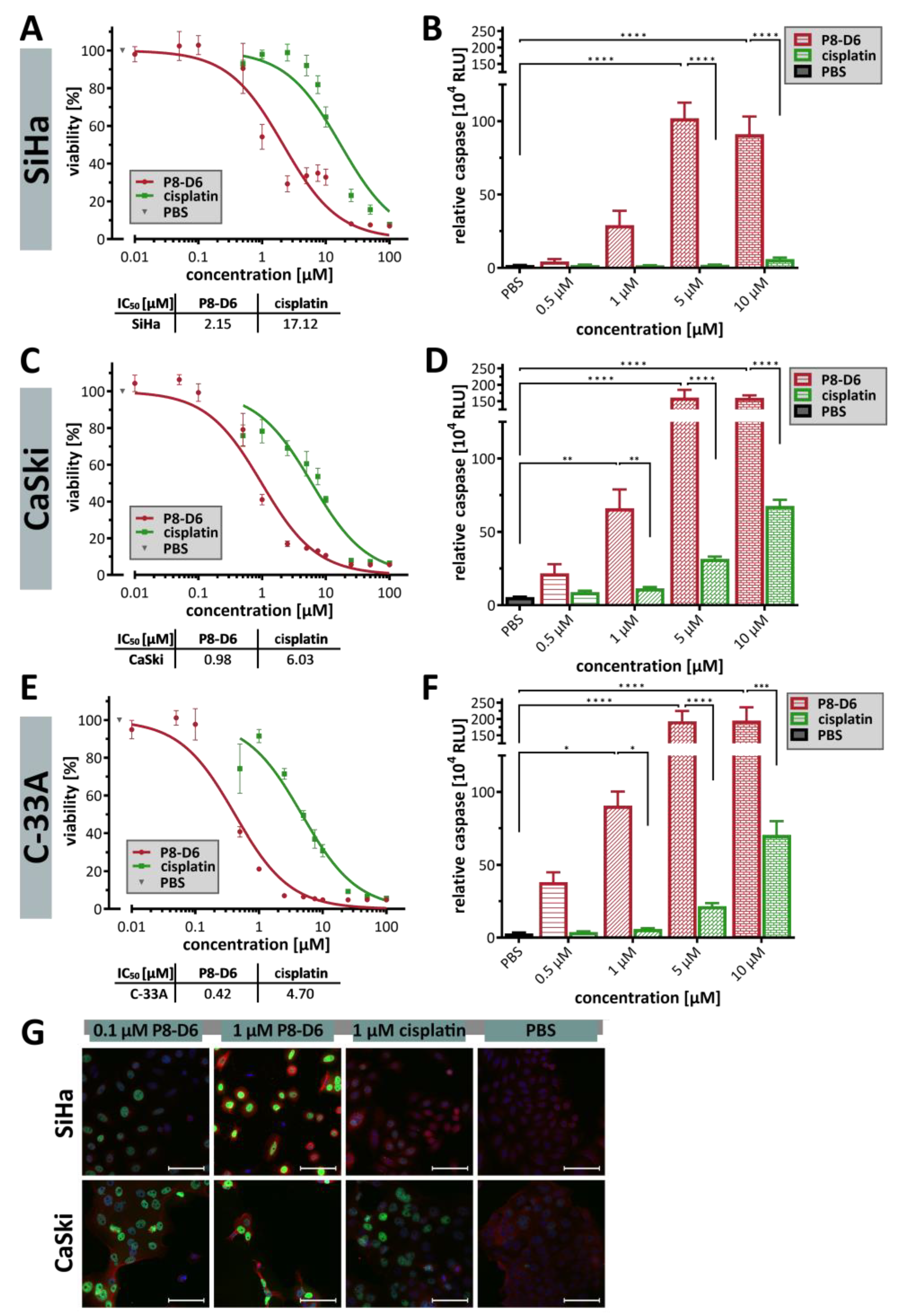
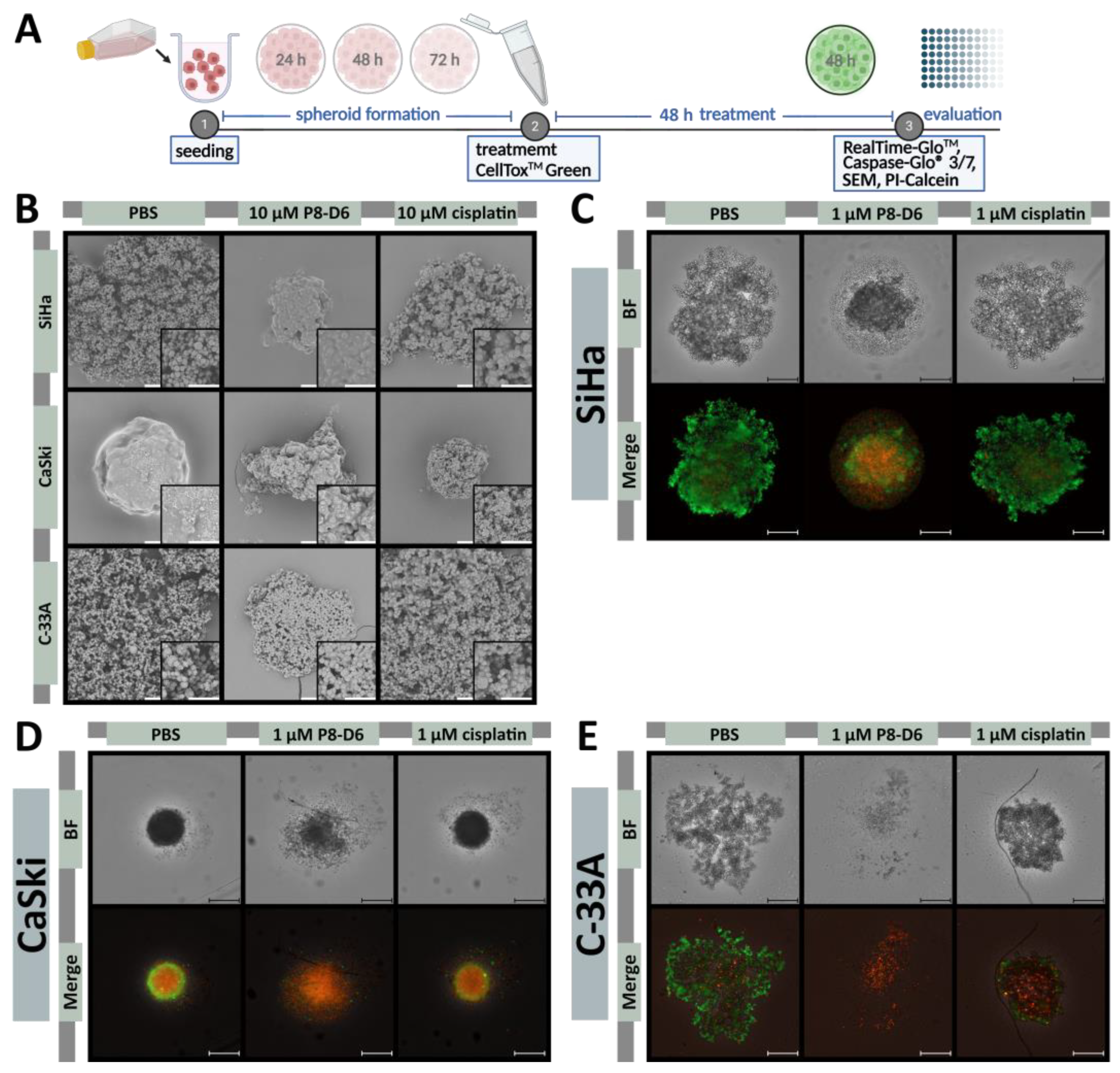
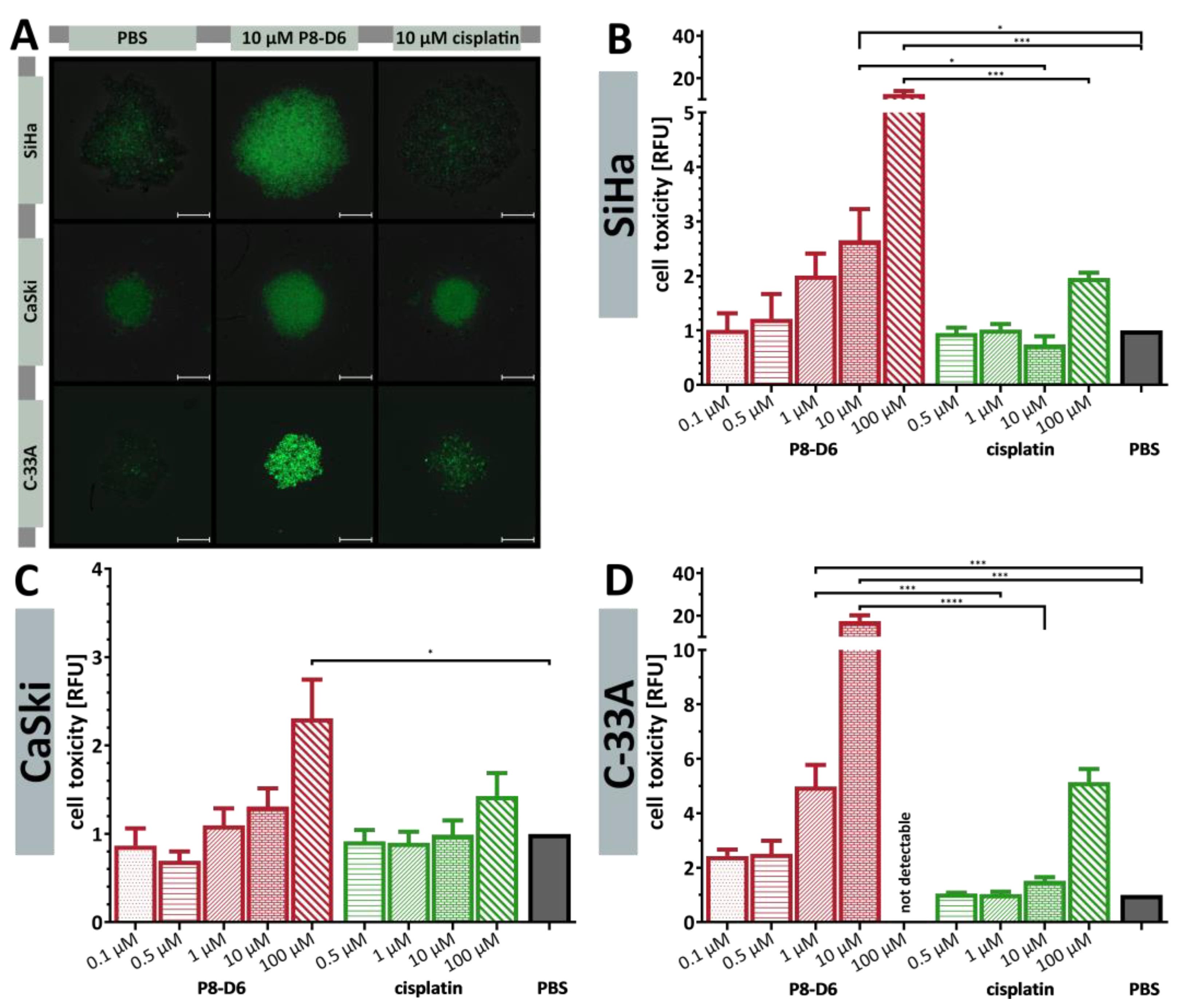
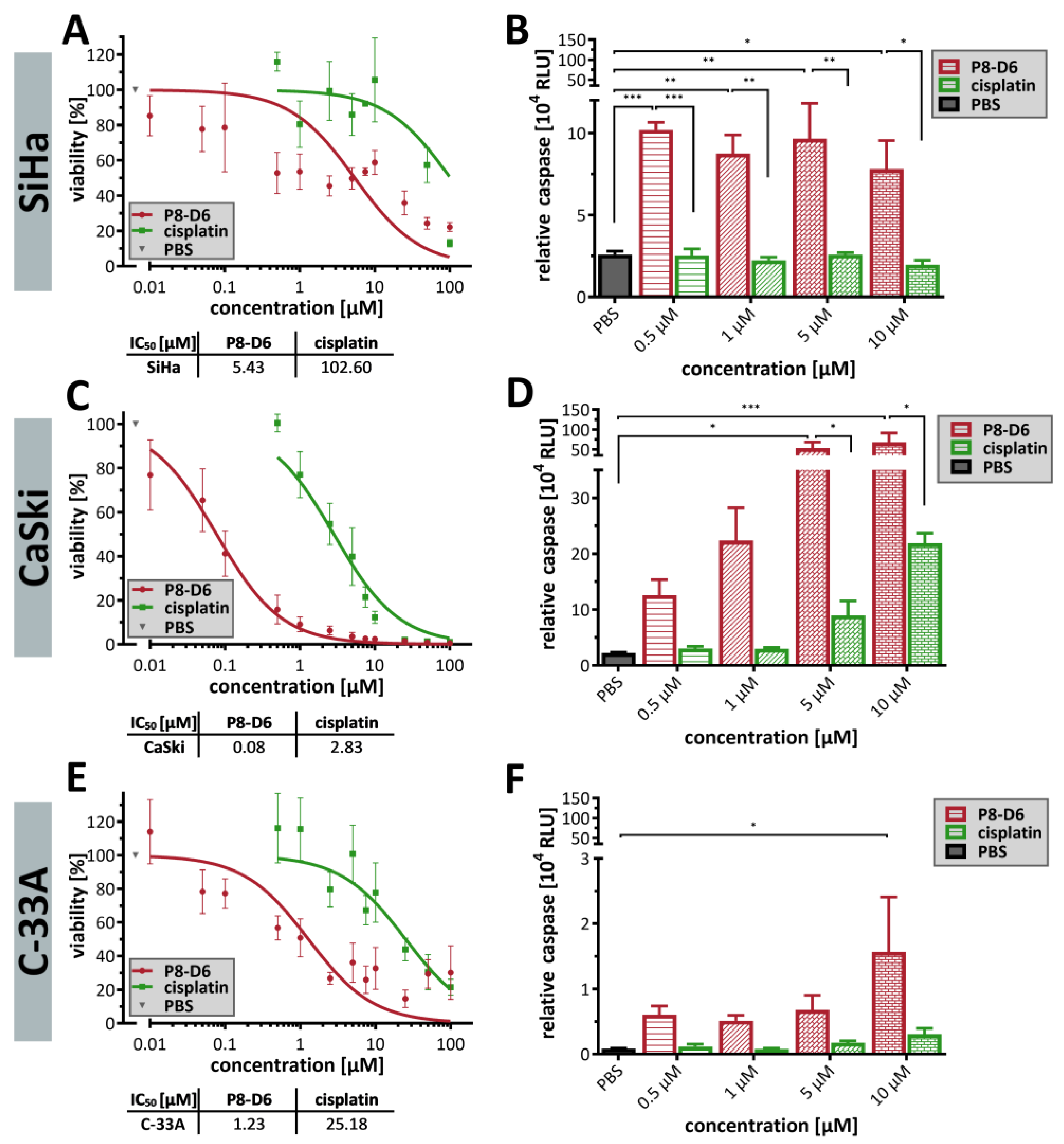
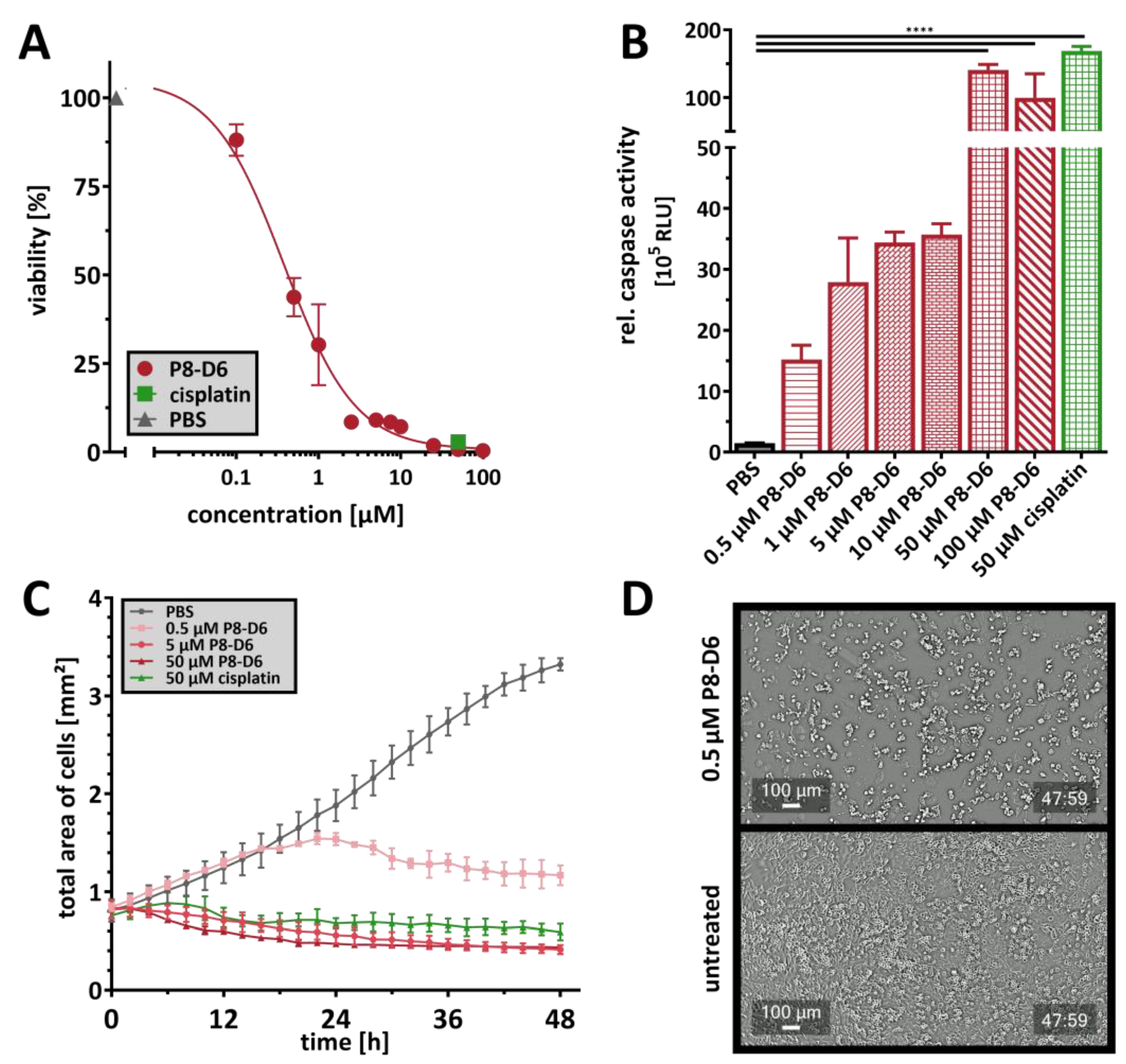
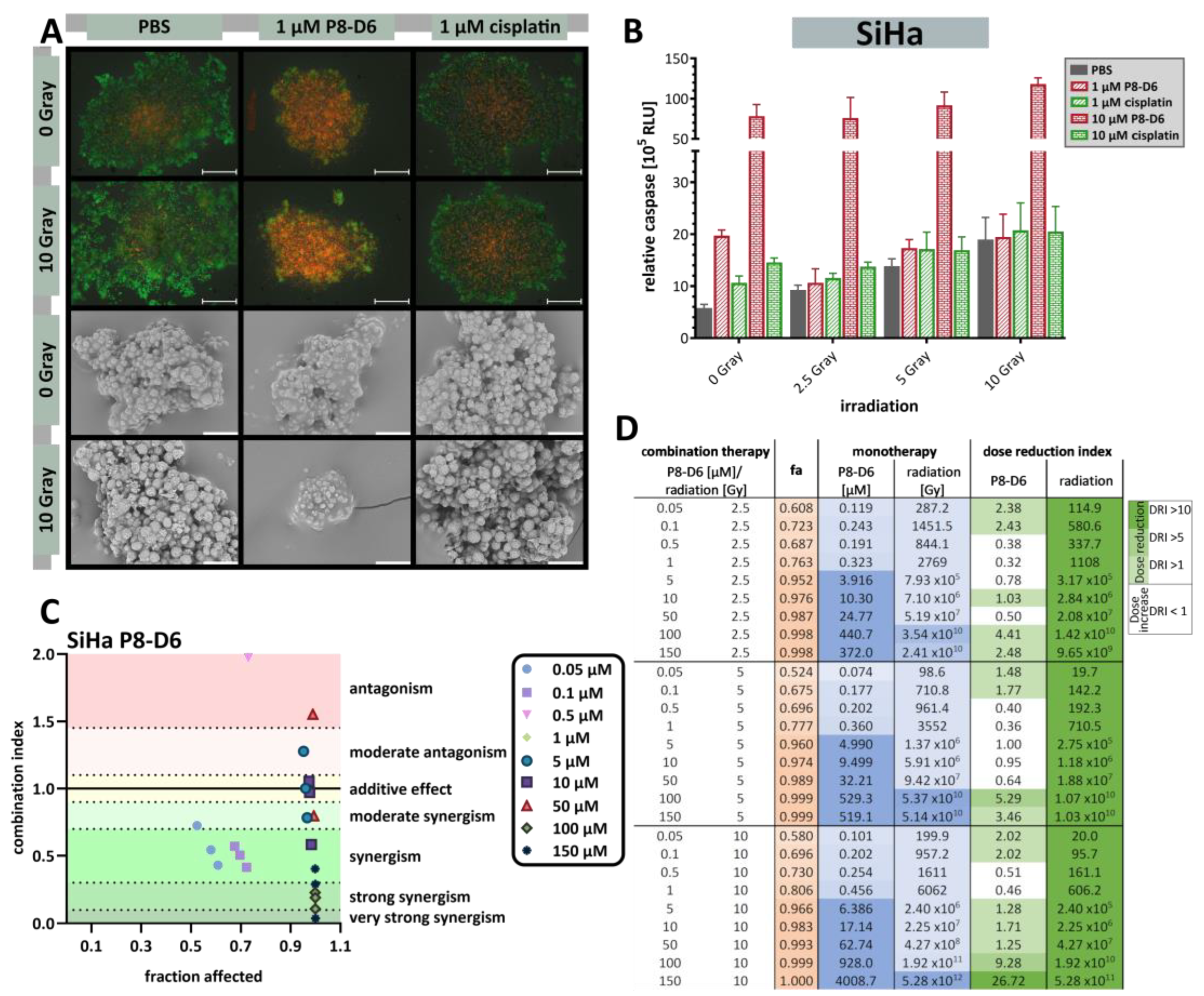
| Genotype | HPV 16 | HPV 18 |
|---|---|---|
| SiHa | + | - |
| CaSki | + | - |
| C-33A | - | - |
Disclaimer/Publisher’s Note: The statements, opinions and data contained in all publications are solely those of the individual author(s) and contributor(s) and not of MDPI and/or the editor(s). MDPI and/or the editor(s) disclaim responsibility for any injury to people or property resulting from any ideas, methods, instructions or products referred to in the content. |
© 2025 by the authors. Licensee MDPI, Basel, Switzerland. This article is an open access article distributed under the terms and conditions of the Creative Commons Attribution (CC BY) license (https://creativecommons.org/licenses/by/4.0/).
Share and Cite
Flörkemeier, I.; Hotze, H.L.; Heyne, A.L.; Hildebrandt, J.; Weimer, J.P.; Hedemann, N.; Rogmans, C.; Holthaus, D.; Siebert, F.-A.; Hirt, M.; et al. Dual Topoisomerase Inhibitor Is Highly Potent and Improves Antitumor Response to Radiotherapy in Cervical Carcinoma. Int. J. Mol. Sci. 2025, 26, 2829. https://doi.org/10.3390/ijms26072829
Flörkemeier I, Hotze HL, Heyne AL, Hildebrandt J, Weimer JP, Hedemann N, Rogmans C, Holthaus D, Siebert F-A, Hirt M, et al. Dual Topoisomerase Inhibitor Is Highly Potent and Improves Antitumor Response to Radiotherapy in Cervical Carcinoma. International Journal of Molecular Sciences. 2025; 26(7):2829. https://doi.org/10.3390/ijms26072829
Chicago/Turabian StyleFlörkemeier, Inken, Hannah L. Hotze, Anna Lena Heyne, Jonas Hildebrandt, Jörg P. Weimer, Nina Hedemann, Christoph Rogmans, David Holthaus, Frank-André Siebert, Markus Hirt, and et al. 2025. "Dual Topoisomerase Inhibitor Is Highly Potent and Improves Antitumor Response to Radiotherapy in Cervical Carcinoma" International Journal of Molecular Sciences 26, no. 7: 2829. https://doi.org/10.3390/ijms26072829
APA StyleFlörkemeier, I., Hotze, H. L., Heyne, A. L., Hildebrandt, J., Weimer, J. P., Hedemann, N., Rogmans, C., Holthaus, D., Siebert, F.-A., Hirt, M., Polten, R., Morgan, M., Klapdor, R., Schambach, A., Dempfle, A., Maass, N., van Mackelenbergh, M. T., Clement, B., & Bauerschlag, D. O. (2025). Dual Topoisomerase Inhibitor Is Highly Potent and Improves Antitumor Response to Radiotherapy in Cervical Carcinoma. International Journal of Molecular Sciences, 26(7), 2829. https://doi.org/10.3390/ijms26072829







